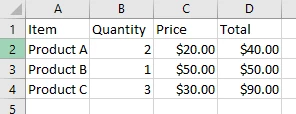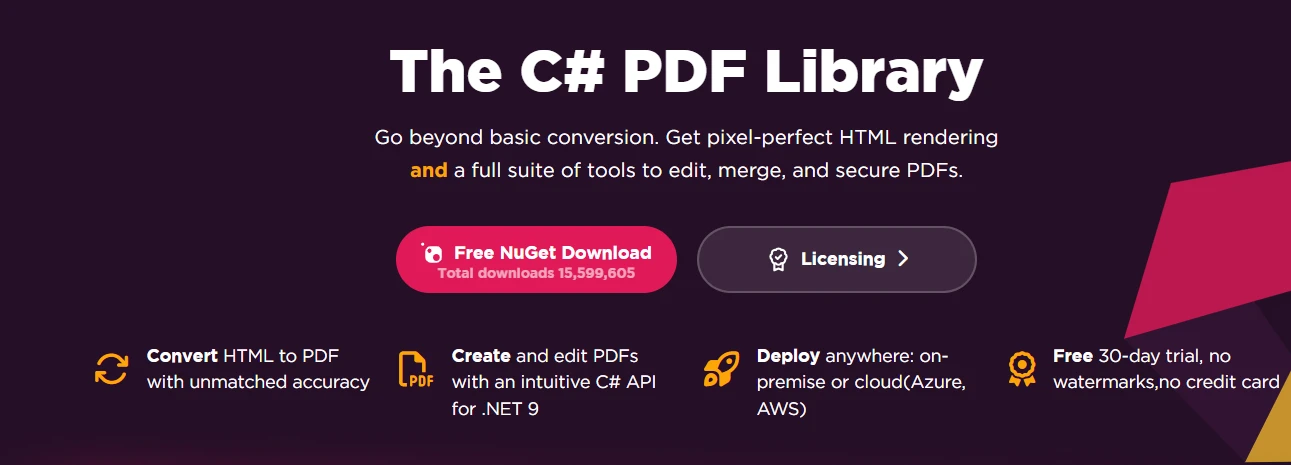How to Extract Data from a PDF in .NET
PDF documents are everywhere in business; modern examples include invoices, reports, contracts, and manuals. But getting the vital info out of them programmatically can be tricky. PDFs focus on how things look, not on how data can be accessed.
For .NET developers, IronPDF is a powerful .NET PDF library that makes it easy to extract data from PDF files. You can pull text, tables, form fields, images, and attachments straight from input PDF documents. Whether you’re automating invoice processing, building a knowledge base, or generating reports, this library saves a lot of time.
This guide will walk you through practical examples of extracting textual content, tabular data, and form field values, with explanations after each code snippet so you can adapt them to your own projects.
Getting Started with IronPDF
Installing IronPDF takes seconds via NuGet Package Manager. Open your Package Manager Console and run:
Install-Package IronPdf
Once installed, you can immediately start processing input PDF documents. Here's a minimal .NET example that demonstrates the simplicity of IronPDF's API:
using IronPdf;
// Load any PDF document
var pdf = PdfDocument.FromFile("document.pdf");
// Extract all text with one line
string allText = pdf.ExtractAllText();
Console.WriteLine(allText);using IronPdf;
// Load any PDF document
var pdf = PdfDocument.FromFile("document.pdf");
// Extract all text with one line
string allText = pdf.ExtractAllText();
Console.WriteLine(allText);IRON VB CONVERTER ERROR developers@ironsoftware.comThis code loads a PDF and extracts every bit of text. IronPDF automatically handles complex PDF structures, form data, and encodings that typically cause issues with other libraries. The extracted data from PDF documents can be saved to a text file or processed further for analysis.
Practical tip: You can save the extracted text to a .txt file for later processing, or parse it to populate databases, Excel sheets, or knowledge bases. This method works well for reports, contracts, or any PDF where you just need the raw text quickly.
Extract Data from PDF Documents
Real-world applications often require precise data extraction. IronPDF offers multiple methods to target valuable information from specific pages within a PDF. For this example, we'll use the following PDF:
The following code will extract data from specific pages within this PDF and return the results to our console.
using IronPdf;
using System;
// Load any PDF document
var pdf = PdfDocument.FromFile("AnnualReport2024.pdf");
// Extract from selected pages
int[] pagesToExtract = { 0, 2, 4 }; // Pages 1, 3, and 5
foreach (var pageIndex in pagesToExtract)
{
string pageText = pdf.ExtractTextFromPage(pageIndex);
// Split on 2 or more spaces (tables often flatten into space-separated values)
var tokens = Regex.Split(pageText, @"\s{2,}");
foreach (string token in tokens)
{
// Match totals, invoice headers, and invoice rows
if (token.Contains("Invoice") || token.Contains("Total") || token.StartsWith("INV-"))
{
Console.WriteLine($"Important: {token.Trim()}");
}
}
}using IronPdf;
using System;
// Load any PDF document
var pdf = PdfDocument.FromFile("AnnualReport2024.pdf");
// Extract from selected pages
int[] pagesToExtract = { 0, 2, 4 }; // Pages 1, 3, and 5
foreach (var pageIndex in pagesToExtract)
{
string pageText = pdf.ExtractTextFromPage(pageIndex);
// Split on 2 or more spaces (tables often flatten into space-separated values)
var tokens = Regex.Split(pageText, @"\s{2,}");
foreach (string token in tokens)
{
// Match totals, invoice headers, and invoice rows
if (token.Contains("Invoice") || token.Contains("Total") || token.StartsWith("INV-"))
{
Console.WriteLine($"Important: {token.Trim()}");
}
}
}IRON VB CONVERTER ERROR developers@ironsoftware.comThis example shows how to extract text from PDF documents, search for key information, and prepare it for storage in data files or a knowledge base. The ExtractTextFromPage() method maintains the document's reading order, making it perfect for document analysis and content indexing tasks.
Extracting Table Data from PDF Documents
Tables in PDF files don't have a native structure; they are simply textual content positioned to look like tables. IronPDF extracts tabular data while preserving layout, so you can process it into Excel or text files. For this example, we'll be using this PDF:
using IronPdf;
using System.Text;
using System.Text.RegularExpressions;
var pdf = PdfDocument.FromFile("example.pdf");
string rawText = pdf.ExtractAllText();
// Split into lines for processing
string[] lines = rawText.Split('\n');
var csvBuilder = new StringBuilder();
foreach (string line in lines)
{
if (string.IsNullOrWhiteSpace(line) || line.Contains("Page"))
continue;
string[] rawCells = Regex.Split(line.Trim(), @"\s+");
string[] cells;
// If the line starts with "Product", combine first two tokens as product name
if (rawCells[0].StartsWith("Product") && rawCells.Length >= 5)
{
cells = new string[rawCells.Length - 1];
cells[0] = rawCells[0] + " " + rawCells[1]; // Combine Product + letter
Array.Copy(rawCells, 2, cells, 1, rawCells.Length - 2);
}
else
{
cells = rawCells;
}
// Keep header or table rows
bool isTableOrHeader = cells.Length >= 2
&& (cells[0].StartsWith("Item") || cells[0].StartsWith("Product")
|| Regex.IsMatch(cells[0], @"^INV-\d+"));
if (isTableOrHeader)
{
Console.WriteLine($"Row: {string.Join("|", cells)}");
string csvRow = string.Join(",", cells).Trim();
csvBuilder.AppendLine(csvRow);
}
}
// Save as CSV for Excel import
File.WriteAllText("extracted_table.csv", csvBuilder.ToString());
Console.WriteLine("Table data exported to CSV");using IronPdf;
using System.Text;
using System.Text.RegularExpressions;
var pdf = PdfDocument.FromFile("example.pdf");
string rawText = pdf.ExtractAllText();
// Split into lines for processing
string[] lines = rawText.Split('\n');
var csvBuilder = new StringBuilder();
foreach (string line in lines)
{
if (string.IsNullOrWhiteSpace(line) || line.Contains("Page"))
continue;
string[] rawCells = Regex.Split(line.Trim(), @"\s+");
string[] cells;
// If the line starts with "Product", combine first two tokens as product name
if (rawCells[0].StartsWith("Product") && rawCells.Length >= 5)
{
cells = new string[rawCells.Length - 1];
cells[0] = rawCells[0] + " " + rawCells[1]; // Combine Product + letter
Array.Copy(rawCells, 2, cells, 1, rawCells.Length - 2);
}
else
{
cells = rawCells;
}
// Keep header or table rows
bool isTableOrHeader = cells.Length >= 2
&& (cells[0].StartsWith("Item") || cells[0].StartsWith("Product")
|| Regex.IsMatch(cells[0], @"^INV-\d+"));
if (isTableOrHeader)
{
Console.WriteLine($"Row: {string.Join("|", cells)}");
string csvRow = string.Join(",", cells).Trim();
csvBuilder.AppendLine(csvRow);
}
}
// Save as CSV for Excel import
File.WriteAllText("extracted_table.csv", csvBuilder.ToString());
Console.WriteLine("Table data exported to CSV");IRON VB CONVERTER ERROR developers@ironsoftware.comTables in PDFs are usually just text positioned to look like a grid. This check helps determine if a line belongs to a table row or header. By filtering out headers, footers, and unrelated text, you can extract clean tabular data from a PDF, and it will be ready for CSV or Excel.
This workflow works for PDF forms, financial documents, and reports. You can later convert the data from PDFs into xlsx files or mergethem into a zip file containing all useful data. For complex tables with merged cells, you might need to adjust the parsing logic based on column positions.

Extract Form Field data from PDFs
IronPDF also allows form field data extraction and modification:
using IronPdf;
using System.Drawing;
using System.Linq;
var pdf = PdfDocument.FromFile("form_document.pdf");
// Extract form field data
var form = pdf.Form;
foreach (var field in form) // Removed '.Fields' as 'FormFieldCollection' is enumerable
{
Console.WriteLine($"{field.Name}: {field.Value}");
// Update form values if needed
if (field.Name == "customer_name")
{
field.Value = "Updated Value";
}
}
// Save modified form
pdf.SaveAs("updated_form.pdf");using IronPdf;
using System.Drawing;
using System.Linq;
var pdf = PdfDocument.FromFile("form_document.pdf");
// Extract form field data
var form = pdf.Form;
foreach (var field in form) // Removed '.Fields' as 'FormFieldCollection' is enumerable
{
Console.WriteLine($"{field.Name}: {field.Value}");
// Update form values if needed
if (field.Name == "customer_name")
{
field.Value = "Updated Value";
}
}
// Save modified form
pdf.SaveAs("updated_form.pdf");IRON VB CONVERTER ERROR developers@ironsoftware.comThis snippet extracts form field values from PDFs and lets you update them programmatically. This makes it easy to process PDF forms and extract specified bounds of information for analysis or report generation. This is useful for automating workflows such as customer onboarding, survey processing, or data validation.

Next Steps
IronPDF makes PDF data extraction in .NET practical and efficient. You can extract images, text, tables, form fields, and even extract attachments from a variety of PDF documents, including scanned PDFs that normally require extra OCR handling.
Whether your goal is building a knowledge base, automating reporting workflows, or extracting data from financial PDFs, this library gives you the tools to get it done without manual copying or error-prone parsing. It’s simple, fast, and integrates directly into Visual Studio projects. Give it a try, you’ll likely save a lot of time and avoid the usual headaches of working with PDFs.
Ready to implement PDF data extraction in your applications? Does IronPDF sound like the .NET library for you? Start your free trial for commercial use. Visit our documentation for comprehensive guides and API references.
Frequently Asked Questions
What is the best way to extract text from PDF documents using .NET?
Using IronPDF, you can easily extract text from PDF documents in .NET applications. It provides methods to retrieve text data efficiently, ensuring you can access the content you need.
Can IronPDF handle scanned PDFs for data extraction?
Yes, IronPDF supports OCR (Optical Character Recognition) to process and extract data from scanned PDFs, making it possible to access text even in image-based documents.
How can I extract tables from a PDF using C#?
IronPDF provides features to parse and extract tables from PDF documents in C#. You can use specific methods to identify and retrieve table data accurately.
What are the benefits of using IronPDF for PDF data extraction?
IronPDF offers a comprehensive solution for PDF data extraction, including text retrieval, table parsing, and OCR for scanned documents. It integrates seamlessly with .NET applications, providing a reliable and efficient way to handle PDF data.
Is it possible to extract images from a PDF using IronPDF?
Yes, IronPDF allows you to extract images from PDFs. This feature is useful if you need to access and manipulate images embedded within PDF documents.
How does IronPDF handle complex PDF layouts during data extraction?
IronPDF is designed to manage complex PDF layouts by offering robust tools to navigate and extract data, ensuring you can handle documents with intricate formatting and structure.
Can I automate PDF data extraction in a .NET application?
Absolutely. IronPDF can be integrated into .NET applications to automate PDF data extraction, streamlining processes that require regular and consistent data retrieval.
What programming languages can I use with IronPDF for PDF data extraction?
IronPDF is primarily used with C# in the .NET framework, offering extensive support and functionality for developers looking to extract data from PDFs programmatically.
Does IronPDF support extracting metadata from PDF documents?
Yes, IronPDF can extract metadata from PDF documents, allowing you to access information such as the author, creation date, and other document properties.
What sample code is available for learning PDF data extraction with IronPDF?
The developer guide provides complete C# tutorials with working code examples to help you master PDF data extraction using IronPDF in your .NET applications.

















